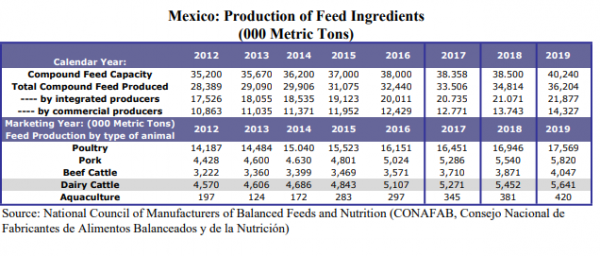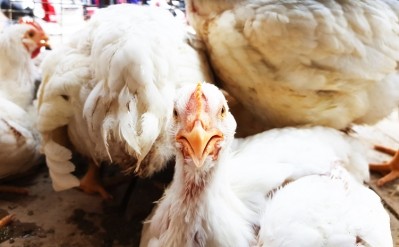Expanding animal production to boost Mexico’s feed import needs

The US Department of Agriculture (USDA) released information about Mexico’s annual and feed production in an agricultural specialist’s report on Tuesday [March 17].
Overall feed grain production is expected to be “mixed” in 2020, the specialist said. Wheat and sorghum production is expected to remain steady while corn production increases.
“In MY 2019/20, imports are expected to continue their modest growth to meet growing demand for livestock feed,” he said. “The United States is expected to remain Mexico’s principal supplier due to logistical advantages and existing business relationships.”
However, changes in federal commercialization support programs for medium or large grain producers are creating uncertainty regarding upcoming planting intentions, he said. Support programs for smaller producers have been maintained, while those for commercial operations has declined or been cut.
“This new focus has generated frustration and great discomfort with medium-sized and large farmers due to the lack of support for commercial agriculture,” he said. The “factor that could most affect grain and oilseed production in MY 2020/21 and upcoming years is the cancellation of the main federal support programs for medium and large growers.”
Corn production and use
The forecast for corn production in 2020/21 anticipates the crop reaching 27.1m metric tons (MT), with 7.3m hectares harvested, the specialist said. The increase in production is based on a larger area being harvested.
“The harvested area and production in MY 2019/20 were lower than a year earlier due to adverse dry weather conditions,” he said. “Similarly, the expected production in the 2019/20 fall/winter crop cycle is expected to decrease approximately 750,000 MT compared with last year’s harvest, due to the drought that affected water reservoirs in the main producing state of Sinaloa.”
The planted area in Sinaloa declined about 16% during the 2019/20 fall/winter crop cycle, he added.
However, corn remains a primary crop in Mexico and consumption in MY 2020/21 is forecast to reach 45.5m MT – an increase of 2.4% from the previous year, the specialist said. “Most of the increase is accounted for by greater feed use, although food use is also expected to rise slightly.”
“Increases in corn for feed consumption is largely explained by the changes in diet patterns and increased income and expenditure by the population on animal proteins,” he said. “At higher consumer incomes, expenditures on cereals and basic crops tend to decrease, while the expenditure for the consumption of poultry, pork and beef meats, milk and eggs increases.”
In 2020, the animal feed industry in Mexico is expected to grow by 3 or 4%, he said. Corn is used in animal feed both by itself and as an ingredient in compound feed.
The poultry industry continues to be the main user of feed grains in Mexico and it expanded by 3% in 2019, he said. The growth trend for poultry production is anticipated to continue into 2020.
Consumption of poultry products is expanding based on affordability and an increasing reputation as a healthier animal protein, the specialist said. The livestock sector is also growing as farms see vertical integration and improved biosecurity.
Livestock exports set a record in 2019 and the trend is anticipated to continue in 2020 based on steady feed prices, he said. Beef exports are predicted to increase to Asia and domestic pork consumption is expanding.
The increase in domestic use is expected to lower ending stocks for MY 2020/21, he said. They are anticipated to drop to 2.2m MT.
Corn trade
Total imports in MY 2020/21 are forecast to expand by about 5.5% based on bullish feed demand and stock rebuilding, the specialist said.
“For MY 2020/21, the corn export forecast for Mexico is expected to remain unchanged at 600,000 MT, due to the cancellation of the governmental export support program,” he said. Estimated exports for 2019/20 were reduced to 600,000 MT based on the end of the support program.
“In general, Mexico continues to consume corn at a higher rate than it produces and depends increasingly on US imports, where producers and consumers find a more competitive price,” he said. “Growth in feed use, particularly for the poultry sector, has been a major driver, maintaining corn import demand in the last few years.
“This trend is forecast to continue in MY 2020/21, based on the optimistic perspective of the animal feed sector and UNA [National Union of Poultry Farmers],” he added.
Estimated imports in 2019/20 dropped slightly to 17.3m MT as there was higher than anticipated domestic production, the specialist said.
The US remains the predominant supplier of corn to Mexico based, he said. In the calendar year 2019, Mexico imported 11% of its corn from Brazil and 89% for the US.
Sorghum growth and trade
Sorghum production in MY 2020/21 is expected to be 4.5m MT with about 1.35m hectares harvested – amounts consistent with previous years, the specialist said.
“The lack of governmental supports for medium and big sorghum farmers is the main factor discouraging an increase in sorghum planting area and limiting the use of inputs,” he said. Producers from medium and large-sized facilities had protests about the reduced support for commercial agriculture.
Use of the feed grain is expected increase by 4.1% to 5.1m MT in MY2020/21, he said. The uptick is based on strong demand from feed millers and the livestock sector.
“Total sorghum imports in MY 2020/21 are forecast at 750,000, up 7% from last year’s estimate, based on an expected increase in feed grain demand,” he said. “The United States is expected to continue to supply virtually all these imports due to USMCA access advantages.”
Ending stocks are expected to grow in 2020/21 reaching 135,000 MT, the specialist said.
Wheat growth, use considerations
Total wheat production in 2020/21 is anticipated to be 3.3m MT with about 605,000 hectares harvested, the specialist said.
“Wheat production in Mexico continues to be spread throughout the country, with the largest producing states being Sonora, Baja California and Guanajuato, which together account for approximately 76 percent of total wheat production,” he said.
Weather in some wheat-growing regions has been normal and allowed for crop development during the fall/winter crop cycle, he said. However, producers in Sonora faced dry conditions and only planted about 25,000 hectares out of the 92,000 traditionally planted.
“As a result, several Mayo Valley farmers decided to shift from cristalino wheat to corn and safflower,” the specialist said. “Corn has higher yields and farmers see it as an attractive alternative. Farmers planted approximately 50,000 ha of corn in the 2019/20 fall/winter crop cycle instead of cristalino wheat.”
Use of wheat in feed is predicted to decline in 2020 as it is higher cost than other feed grains including corn, he said. Stocks are expected to increase in 2020/21.














